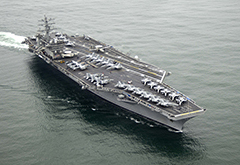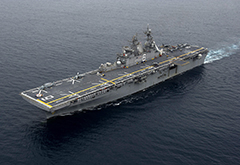1. Gerald R. Ford Class Aircraft Carrier - US:
Gerald R. Ford class (or Ford class, previously known as CVN-21 class), is a class of supercarrier being built to replace some of the United States Navy's existing Nimitz-class carriers, beginning with the delivery of CVN-78, USS Gerald R. Ford. The new vessels have a hull similar to the Nimitz carriers, but introduce technologies since developed such as the Electromagnetic Aircraft Launch System, as well as other design features intended to improve efficiency and reduce operating costs, including sailing with smaller crews. More details
The Nimitz-class supercarriers are a class of ten nuclear-powered aircraft carriers in service with the United States Navy. The lead ship of the class is named for World War II United States Pacific Fleet commander Fleet Admiral Chester W. Nimitz, the U.S. Navy's last fleet admiral. With an overall length of 1,092 ft (333 m) and full-load displacement of over 100,000 long tons, they have been the largest warships built and in service, although they are being eclipsed by the upcoming Gerald R. Ford-class aircraft carriers. As a result of the use of nuclear power, the ships are capable of operating for over 20 years without refueling and are predicted to have a service life of over 50 years. More details
3. HMS Queen Elizabeth Aircraft Carrier - UK:
HMS Queen Elizabeth is the lead ship of the Queen Elizabeth-class of aircraft carrier, the largest warship ever built for the Royal Navy and capable of carrying up to forty aircraft. She was named by Queen Elizabeth II on 4 July 2014. Her first Commanding Officer is Commodore Jerry Kyd, the former captain of HMS Ark Royal and HMS Illustrious. Unlike most large carriers she is not fitted with catapults and arrestor wires and is instead designed to operate V/STOL aircraft; her air wing will typically consist of F-35B Lightning II fighter-bombers and Merlin helicopters for airborne early warning and anti-submarine warfare. More details
4. Liaoning Aircraft Carrier - China:
5. Admiral Kuznetsov Aircraft Carrier - Russia:
Charles de Gaulle (R91) is the flagship of the French Navy (Marine Nationale) and the largest Western European warship. She is the tenth French aircraft carrier, the first French nuclear-powered surface vessel, and the first and so far only nuclear-powered carrier completed outside of the United States Navy. It is named after French statesman and general Charles de Gaulle. The ship has a displacement of 37,085 tons but can reach more than 42,000 tons at full military capacity. More details
Admiral Flota Sovetskogo Soyuza Kuznetsov is an aircraft cruiser (heavy aircraft-carrying missile cruiser, or TAVKR, in Russian classification) serving as the flagship of the Russian Navy. She was built by the Black Sea Shipyard, the sole manufacturer of Soviet aircraft carriers, in Mykolaiv within the Ukrainian Soviet Socialist Republic. The initial name of the ship was Riga; she was launched as Leonid Brezhnev, embarked on sea trials as Tbilisi, and finally named Admiral Flota Sovetskogo Soyuza Kuznetsov. The ship was named after Admiral of the Fleet of the Soviet Union Nikolay Gerasimovich Kuznetsov. More details
6. Charles de Gaulle Aircraft Carrier - France:
7. INS Vikramaditya Aircraft Carrier - India:
INS Vikramaditya (R33) is a modified Kiev-class aircraft carrier which entered into service with the Indian Navy in 2013. She has been renamed in honour of Vikramaditya, a legendary emperor of Ujjain, India. Originally built as Baku and commissioned in 1987, the carrier served with the Soviet Navy and later with the Russian Navy (as Admiral Gorshkov) before being decommissioned in 1996. The carrier was purchased by India on 20 January 2004 after years of negotiations at a final price of $2.35 billion. The ship successfully completed her sea trials in July 2013 and aviation trials in September 2013. More details
USS America (LHA-6), the fourth American warship to be named for the United States of America, is the first of the America-class amphibious assault ships for the U.S. Navy. She was delivered in spring of 2014, replacing Peleliu of the Tarawa class. Her mission is to act as the flagship of an expeditionary strike group or amphibious ready group, carrying part of a Marine expeditionary unit into battle and putting them ashore with helicopters and V-22 Osprey tilt-rotor aircraft, supported by F-35B Lightning II aircraft and helicopter gunships. USS America (LHA-6) has a displacement of 45,000 tons. More details
8. USS America (LHA-6) Aircraft Carrier - US:
9. Cavour Aircraft Carrier - Italy:
Cavour is an Italian aircraft carrier and the newest flagship of the Italian Navy (Marina Militare). She is named after the Italian statesman and politician Camillo Benso, conte di Cavour. Cavour was laid down by Fincantieri on 17 July 2001, and she was launched from the Riva Trigoso shipyard in Sestri Levante, on 20 July 2004. Sea trials began in December 2006, and she was officially commissioned 27 March 2008. Full Operational Capability (FOC) was reached 10 June 2009. Cavour has a displacement of 27,900 tons but can reach more than 30,000 tons at full military capacity, after improvements done in 2008.
10. Juan Carlos I Aircraft Carrier - Spain:









